Intel's Core 2 Extreme & Core 2 Duo: The Empire Strikes Back
by Anand Lal Shimpi on July 14, 2006 12:00 AM EST- Posted in
- CPUs
Application Performance using SYSMark 2004 SE
We'll kick off our look at general application performance with SYSMark 2004 SE and as always, and we'll look at the overall score as well as the scores in each of the two suites - Internet Content Creation and Office productivity.
As we saw in our last preview of Intel's Core 2 Extreme processor, it posted SYSMark scores that were well beyond anything either AMD or Intel had been able to deliver in the past. With the final version of Core 2 silicon in our hands and a more stable/tweaked platform, we got even better numbers out of Conroe:
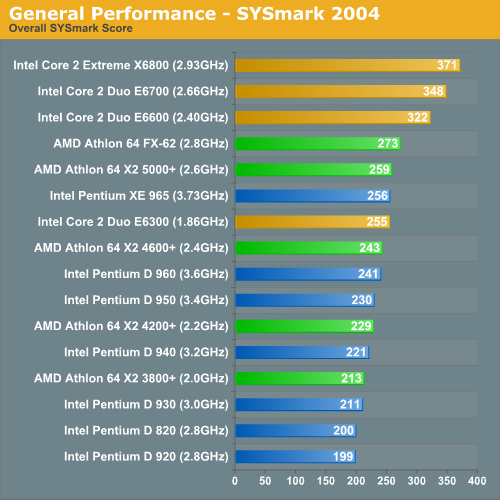
At the high end, the Core 2 Extreme X6800 was just under 36% faster than the Athlon 64 FX-62. In fact, even the $316 E6600 was around 18% faster than AMD's fastest. To add even more insult to injury the slowest Core 2 Duo in the test, the 1.86GHz E6300 is barely slower than AMD's fastest Athlon 64 X2.
The old Intel lineup of Pentium D processors is truly an embarrassment. Only the Extreme Edition 965 is remotely competitive and even then it can barely outperform the $183 E6300.
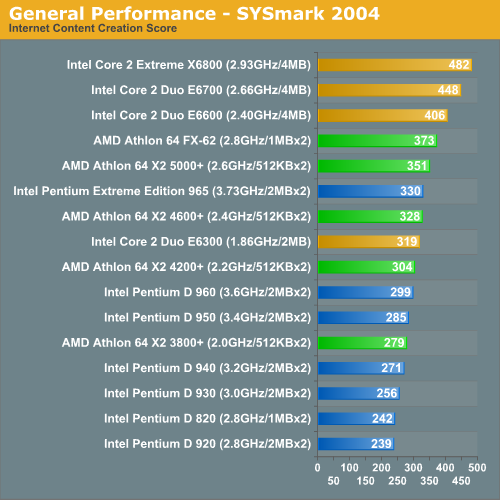
Drilling down into the SYSMark scores we've got the overall ICC results, which honestly are not much different than the overall scores we saw above. The Core 2 Extreme X6800 holds a 29% performance advantage over the FX-62 and once again, and the E6600 is able to outperform AMD's best by over 8%.
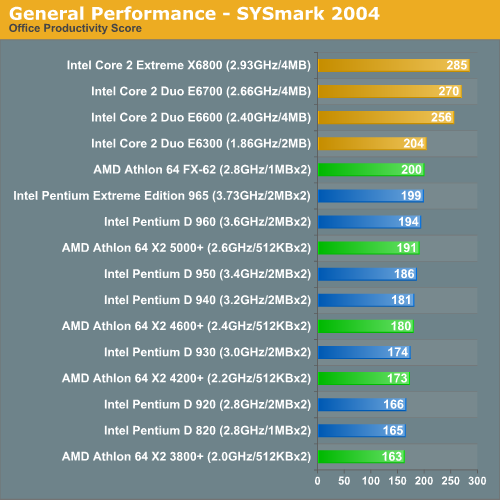
Intel's Core 2 performance domination continues in the Office Productivity portion of SYSMark 2004, with the Core 2 Extreme X6800 maintaining a 42.5% performance advantage over the FX-62. This time around, even the E6300 manages to remain competitive with the FX-62. This is Intel's new $183 part offering performance equal to that of AMD's $1,000 flagship FX processor; it's going to take a lot for AMD to recover from this deficit.
The individual SYSMark 2004 SE scores are graphed below if you're interested. The data is used in calculating the overall scores we've already discussed above:
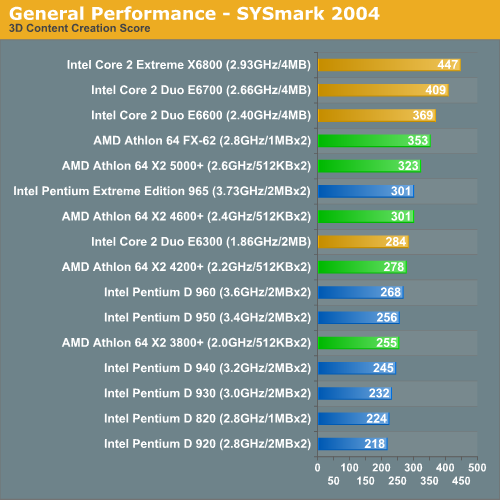
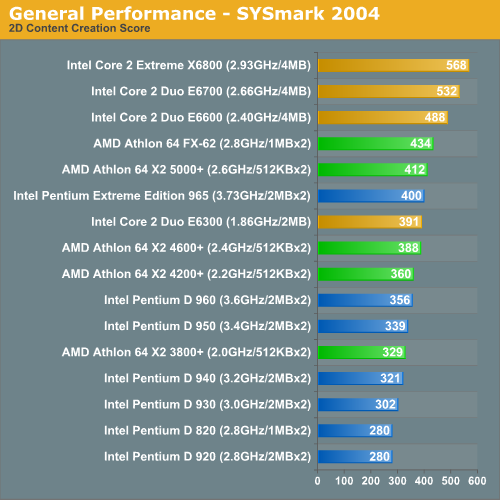
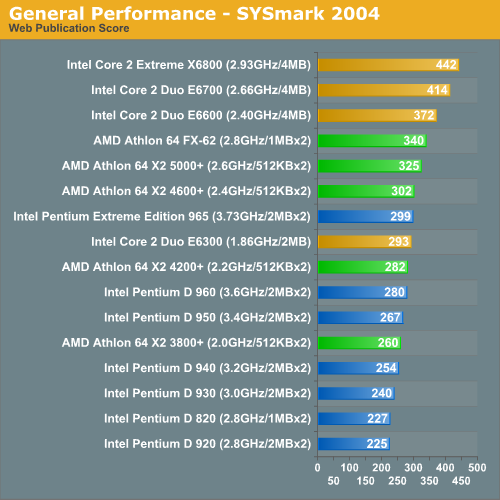
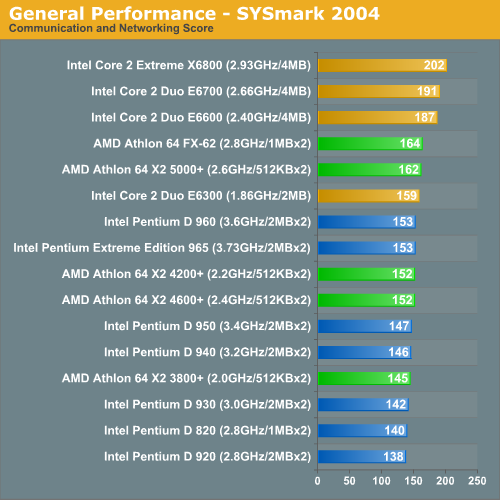
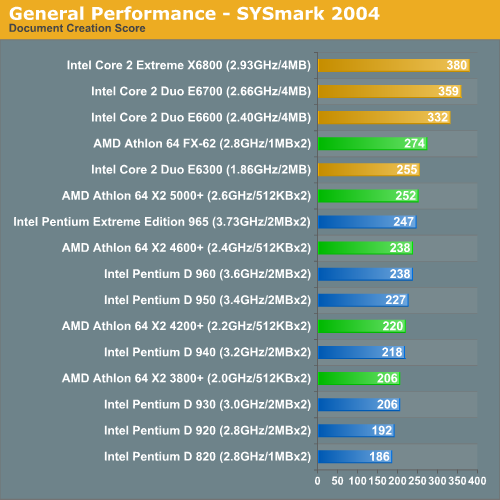
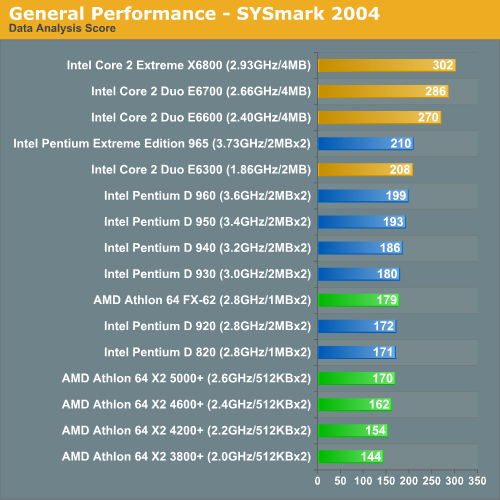










202 Comments
View All Comments
invise - Friday, July 14, 2006 - link
According to page 3 "The Test", you used an Intel D975xBX motherboard (Intel 975X chipset) for the tests in the article. Yet in the picture of the Tuniq Tower on page 18 "Overclocking", there is clearly an Asus board with a gold/copper chipset heatsink, blue PCI-Express 16x slot, and alternating yellow and black DIMM slots. Which board is this? I suspect a P5WD2 or P5N32-SLI, just from looking at pictures online, but from what I can find neither of those has a gold/copper heatsink on the Northbridge.I'm curious because you got the board's FSB stable at 445 MHz, which is critical when working with a CPU with a low, locked multiplier. If any other users recognize the board please ID it.
spug1 - Friday, July 14, 2006 - link
I noticed that too Invise. Can we have some clarification as to whether you used the intel board, or the asus p5w-dh for the testing of conroe?!
cheerz, :)
JarredWalton - Friday, July 14, 2006 - link
Overclocking was done with the ASUS board. The benchmarks scores were tested on the Intel board as reported on page 3.Suraj - Friday, October 20, 2006 - link
What other parts did u change when overclocking? I'm very eager to know what exact parts u used when overclocking the e6600.Kiste - Friday, July 14, 2006 - link
Great review, as always. I have to admit though that I was hoping for a bit more with regard to i965 based mainboards.Gary Key - Friday, July 14, 2006 - link
We have a few P965 boards in house currently, however all of them are undergoing almost daily bios changes. They should be very solid from a performance viewpoint within 30 days but at this time they are still immature and any performance results shown with them are not final.
Wesley Fink - Friday, July 14, 2006 - link
You will see Conroe motherboard reviews the first of the week, and yes, there are 965 boards in the reviews.DrMrLordX - Friday, July 14, 2006 - link
Could you guys please do a mini-review of this chip? In particular, could you overclock it using a Tuniq Tower 120 or something and give us some idea of how high it will go? I've been wanting to know more about that proc since AM2 launched, but AMD has been doing a lousy job of getting them into retail channels.redpriest_ - Friday, July 14, 2006 - link
Very detailed, I loved it. But quick question: Your screenshots with cpuid have the stepping as a B1 stepping 5 Conroe - I bought a retail Conroe X6800, and it was a stepping 6 revB2 - and it "only" clocks to 3.466 ghz stably. 3.733 is unstable and 4 ghz is a no boot into Windows; so my question is - is that the stepping you used or was it just a screenshot from an older comparison?Wesley Fink - Friday, July 14, 2006 - link
Our review samples are all Stepping 5. We also have an earlier Stepping 4 unlocked E6700 that overclocks very well. We understood stepping 5 was the Retail stepping. We will clarify this with Intel later today.